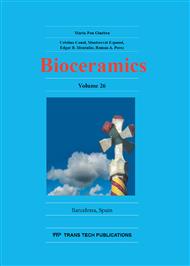p.143
p.151
p.156
p.160
p.166
p.173
p.179
p.184
p.193
Characterization and Bioactivity of Hydroxyapatite-ZrO2 Composites with Commercial Inert Glass (CIG) Addition
Abstract:
Hydroxyapatite is a kind of calcium phosphate that has generated great interest as an advanced orthopedic and dental implant candidate. Although HA has excellent biocompatibility, it’s poor mechanical properties limit its use as an implant material. Therefore HA is preferred as a main component in composite materials. The aim of this study is to determine the characterization and bioactivity of HA-ZrO2 composites with the addition of 5 and 10 wt% commercial inert glass (CIG). The highest density and Vickers microhardness were obtained in HA-ZrO2-5 wt% CIG composite sintered at 1300 °C. The highest compression strength was measured in HA-ZrO2-5 wt% CIG composite sintered at 1200 °C. The in vitro bioactivity tests were performed on the composites having the highest physical and mechanical properties. The apatite formation was observed on all samples subjected to bioactivity tests. As a result, the optimum mechanical properties and bioactivity were obtained on HA-ZrO2- 5 wt% CIG composite sintered at 1200 °C.
Info:
Periodical:
Pages:
166-172
Citation:
Online since:
November 2014
Authors:
Price:
Сopyright:
© 2015 Trans Tech Publications Ltd. All Rights Reserved
Share:
Citation:


